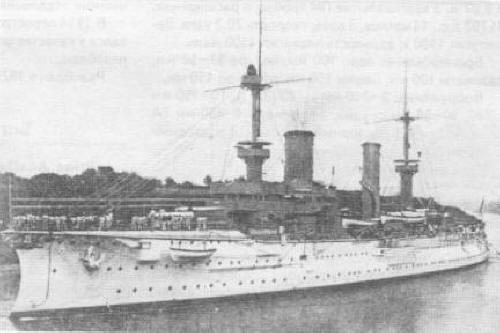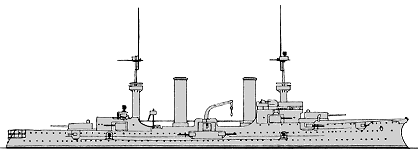
NAVYPEDIA
 Support the project with paypal
Support the project with paypal
Photo

Fürst Bismarck
Ships
| Name | No | Yard No | Builder | Laid down | Launched | Comp | Fate |
|---|---|---|---|---|---|---|---|
| Fürst Bismarck | 23 | Kiel KW | 1895 | 25.9.1897 | 1.4.1900 | stokers TS 3.1915, disarmed 1916 |
Technical data
| Displacement normal, t | 10690 |
|---|---|
| Displacement full, t | 11461 |
| Length, m | 127.0 oa 125.7 wl |
| Breadth, m | 20.4 |
| Draught, m | 7.80 mean 8.46 deep load |
| No of shafts | 3 |
| Machinery | 3 VTE, 4 Thornycroft + 8 cylindrical boilers |
| Power, h. p. | 13500 |
| Max speed, kts | 18.7 |
| Fuel, t | coal 1400 + oil 120 |
| Endurance, nm(kts) | 4560(10) |
| Armour, mm | belt: 200 - 100, deck: 30 with 50mm slopes, main turrets: 200, secondary turrets: 100, casemates: 100, CT: 200 - 100 |
| Armament | 2 x 2 - 238/37 SK L/40 C/97, 12 x 1 - 149/37 SK L/40 C/97, 10 x 1 - 88/27 SK L/30 C/89, 4 x 1 - 7.9/79, 6 - 450 TT (1 bow, 4 beam, 1 stern) |
| Complement | 621 |
Standard scale images

Fürst Bismarck 1900
Graphics
Project history
Fürst Bismarck was Germany's first armoured cruiser, though apart from her narrow but thick belt and more and heavier big guns she was very much an enlarged version of the Victoria Louise class. She was wood-sheathed and spent her first decade in overseas service.
Ship protection
Narrow belt protected all waterline length, was 200mm between main barbettes (tapered to 100mm at lower edge) and 100mm at ship ends and was backed by 200mm wood. 30mm protective deck was connected with its lower edge by 50mm slopes. Fwd CT had 200m sides and 30mm roof, aft CT had 100mm sides and 30mm roof. Main turrets had 200mm sides and 40mm crowns, 4 15cm guns were placed in the turrets with 100mm sides, others were protected by 100mm casemates with 70mm shields.
Modernizations
1915: - 2 x 1 - 149/37, 4 x 1 - 7.7/79
Naval service
She was rebuilt between 1910 and 1915, only to spend a short time in coast defence and then be disarmed and relegated to training stokers in 1916.
 HOME
HOME FIGHTING SHIPS OF THE WORLD
FIGHTING SHIPS OF THE WORLD GERMANY
GERMANY CRUISERS
CRUISERS FÜRST BISMARCK armoured cruiser (1900)
FÜRST BISMARCK armoured cruiser (1900)
